It has been said that fishing and family holidays don’t mix and to some extent this is true. A family holiday should be focused on family fun and this may not coincide with serious fishing effort. However if the location is right and all parties benefit then why not have a cast here and there?
Whenever I go on holiday I pack a small amount of fishing essentials to enable me to target the likely species available. So the first thing to do is a bit of research on the area to be visited. The first port of call is often the internet and a quick google search will often yield results. Keep your eyes scanned for any literature on the area you intend to visit; magazines often have relevant reports or articles. Old guide books are also well worth seeking out and give vital clues as to what may be caught. If possible try to tap into local knowledge. A contact at your destination is ideal, so ask around your mates. Sea angling forums are also worth a try though I have to admit to feeling a little uneasy asking total strangers for info, as they have no obligation to give away their hard earned secrets. Another essential is a tide table to enable careful planning of trips to coincide with the ideal tidal state.
If the holiday involves flying, luggage will be restricted, so tackle will need to be kept to a minimum. Travel rods are the only practical way forward with multi section or telescopic rods perfect for the job. A small rucksack can be packed with a couple of reels holding relevant lines, tackle and accessories. Bait and some items can be purchased when you arrive at your destination. This year’s holiday took us to the Isle of Scilly.
The Isle’s are a perfect destination for a family vacation with stunning scenery, white sandy beaches, boat trips, a multitude of shops and eateries. In addition to this the water clarity is truly stunning, proving a divers paradise with numerous wrecks and reefs over which to dive or snorkel.
The waters around Scilly have a rich population of fish for the angler to target with pollock, mackerel, garfish, grey mullet and wrasse perfect species for the holiday angler. Strangely, bass are very rare which surprised me as the habitat seems ideal. The angler prepared to take a boat trip could be rewarded with a blue shark. A shark topping 150lb was tagged and released from a boat during our stay. Evening trips are available with the shark grounds within easy distance of the islands.
My intention on this holiday was to have a go for the large thick-lipped grey mullet and perhaps try for a golden grey that populate many of the sandy beaches. There was also the opportunity to target wrasse or Pollock from deepwater rocky headlands.
I had been fortunate to make contact with an experienced local angler who gave us valuable advice on possible marks and location of species.
So with the species and terrain involved this is what we packed to enable my sixteen-year-old son James and I to have a cast or two.
TACKLE
Shimano – Travel spinning rod
ABU – Telescopic spinning
Shimano fixed spool reels.
One spool loaded with 8lb b.s mono and the second with 20lb b.s braid.
Small Snowbee rucksack.
1 pack Berkley jelly worms
1 Pack Berkley sandeel’s
Selection of floats
Weights up to 1 oz x 6
Split shot
Selection of hooks Sakuma sizes 8 to 3/0
Three way swivels
15lb b.s fluorocarbon hook length
8 lb.s fluorocarbon hook length
Forceps and line clips
Scissors
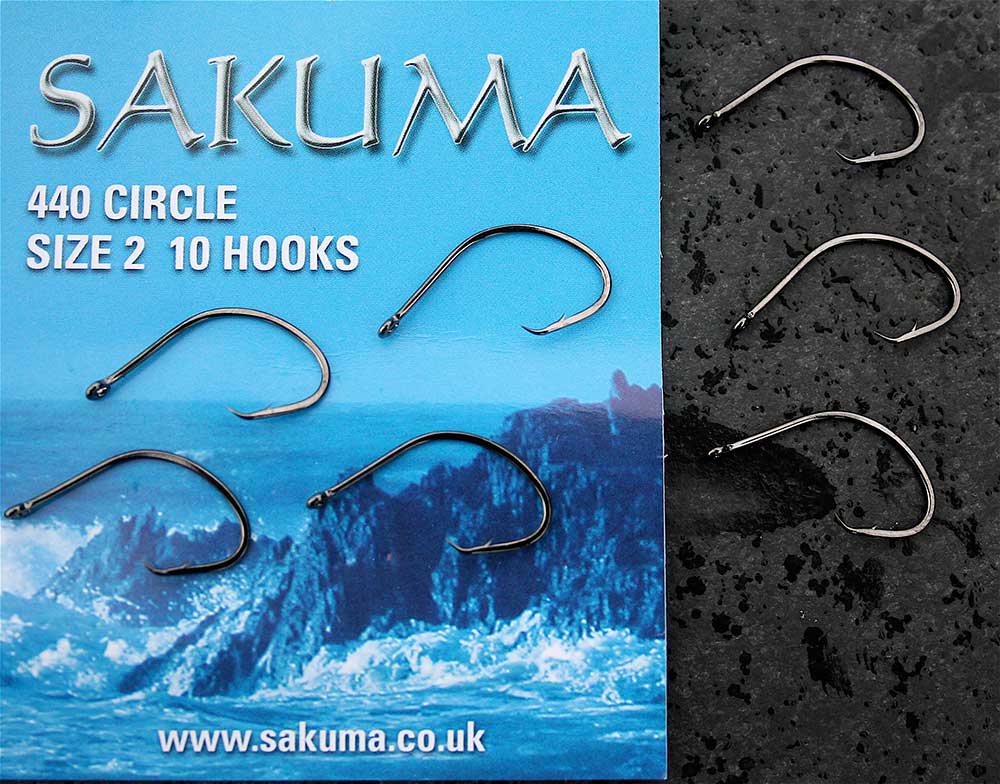
Armed with these basic bits of kit, it is possible to target a range of species. If we were visiting other venues I would review the artificials taken, substituting the jelly worms for plugs or spinners, if bass were likely to be present.
During our weeklong stay on St Mary’s my son and I enjoyed three short fishing sessions.
FIRST SESSION
The first session saw us walk out onto a headland that gave access to very deep clear water. We should have arrived two hours before high water but failed to get there until about half an hour before the top of the tide. A careful assessment must be made prior to starting to assess a safe place from which to fish. Always beware of large waves and consider tidal state and weather conditions.
My son James and I selected a rock that kept us well above the water with access to land a fish if it was hooked. A simple paternoster rig was used to present a jelly worm. 20lb braid was selected for this that would give us a fighting chance if a decent pollock was hooked. The lure was cast out and allowed to sink before being retrieved. The key is often to get the lure fishing as close to the bottom as possible without getting it snagged. When a Pollock is hooked a degree of pressure is needed to prevent it reaching sanctuary.
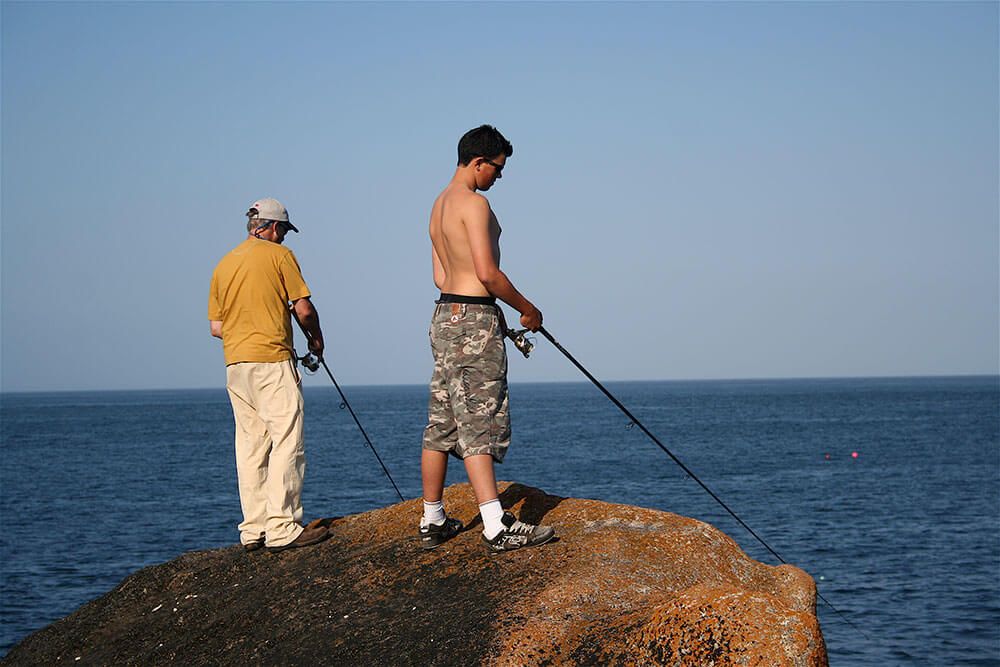
The scenery was truly stunning with lichen covered granite boulders, abundant wild flowers and a dramatic marine panorama. After two or three casts my jelly worm was hit by a small Pollock, this gave a moment of excitement before I realised its small size. After half an hour without further interest in our lures it was time to wonder off along the coast to try a few more spots. A Pollock close in eventually seized James’ jelly worm but in a split second the powerful fish had found sanctuary amongst the rocks.
With the tide now starting to ebb we decided it was time to call it a night. The walk back along the cliff path brought us upon an array of spectacular views. Granite formations, a tranquil bay, small boats at rest, bright wild flowers - all the sights that add to the delights of sea angling.
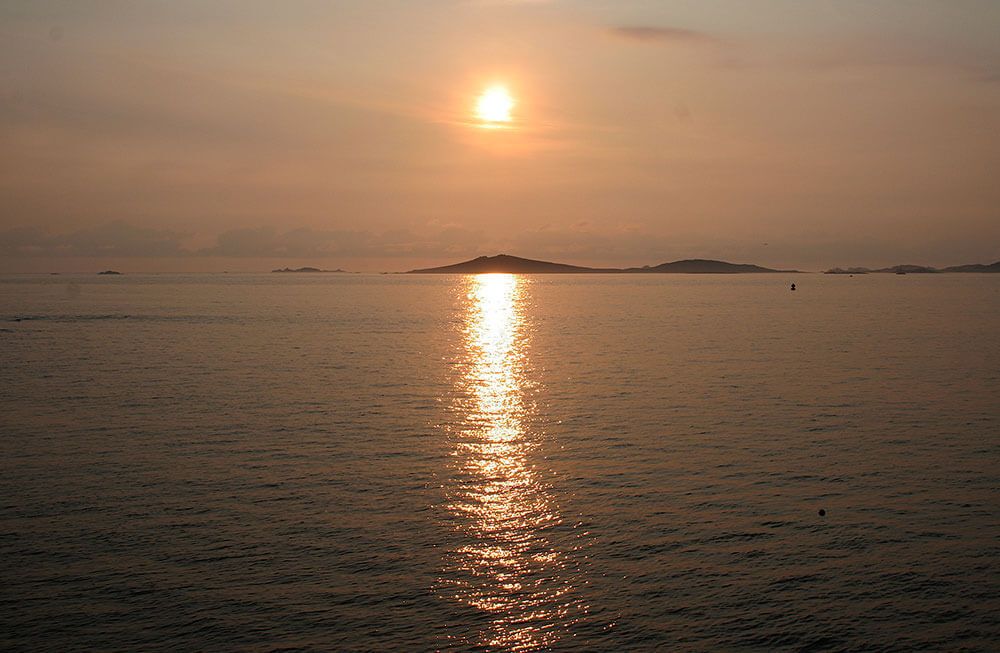
SECOND SESSION
We had been told of a sandy point at the North of the island that produced good catches of golden grey mullet. Low water flood was the time to fish the mark. With this in mind my wife Pauline and son James set off with me along winding country lanes to the mark. This was of course all part of the fun.
As luck would have it the weather forecast gave showers of rain that afternoon, though with warm sunshine when we left home, this seemed unlikely!
Eventually we arrived at the white sandy beach, Pauline prepared to stretch out in the sun whilst James and I headed for the foreshore in search of ragworm which could, I was told, be found beneath boulders that lay to the left and right of the sandy beach. Half an hour of heaving over rocks produced enough harbour rag for a couple of hours fishing.
James and I sauntered back up the beach for a snack with Pauline before using our bait. To our dismay as we sat down large spots of warm rain proceeded to fall. The sky gave no clear indication of how long it would prevail so we decided to give it a few casts despite the rain. Our luck held the rain soon eased.
After half an hour I had a sharp rattle on the rod tip but failed to connect. James then also enjoyed a signal of life transmitted through his braided line but the hook hold failed and it came adrift. Next cast my rod tip again dipped and I found my self attached to a fish of some kind. Seconds later a small brightly coloured wrasse was swung ashore to bring a smile to our faces.
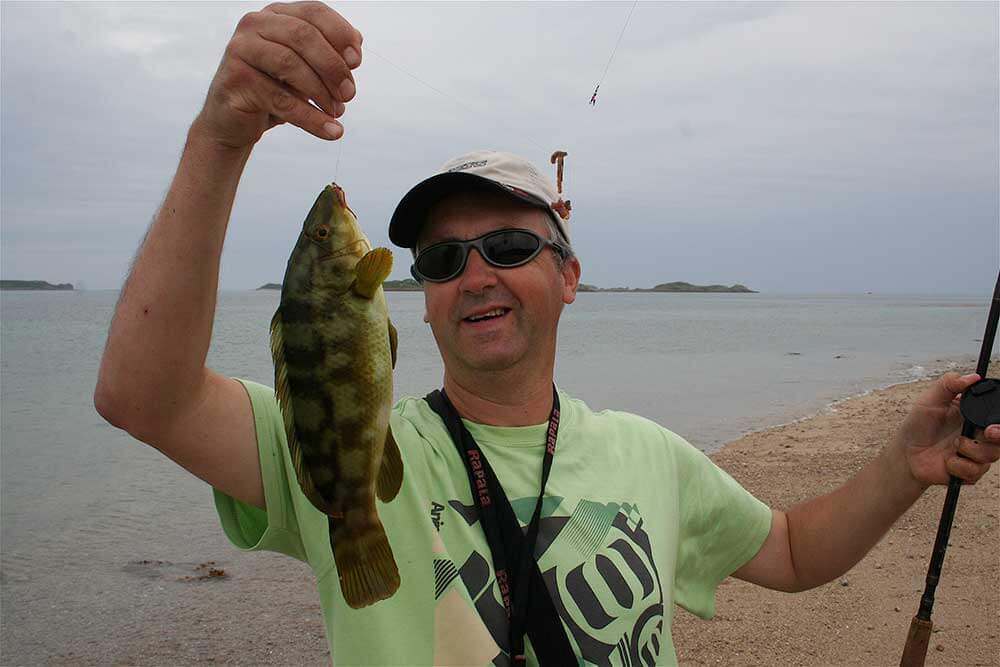
Having fished two hours of the early flood tide it was time to head off to our cottage before walking into Hugh Town for a pub meal.
THIRD SESSION
Time flies far too fast whilst on holiday and our last day on Scilly came all too soon. A beautiful sandy beach with an adjacent rocky promontory was to be our venue. James and I would forage around for a little bait in and under the rocks. I had a loaf or two of bread to try and tempt a mullet.
At low water we walked out onto the end of the rocks. I mashed up a bag full of bread and started to toss it into the clear water. James set up with a simple paternoster rig and rotten bottom. A size 2 Sakuma circle hook was baited with a couple of limpets and swung into a deep kelp filled gully. I set up a light float rig in case a mullet or two appeared.
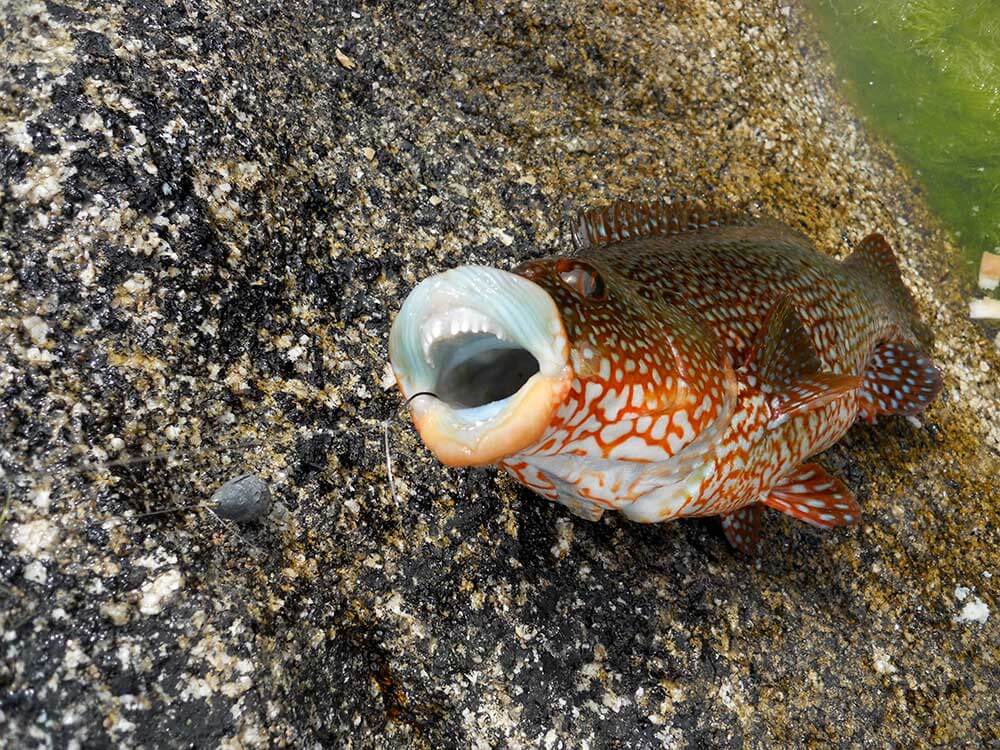
After a few minutes James called out and I turned to see his rod bent over its tip jagging to the pull of a fish. James applied plenty of pressure as instructed and bullied the fish towards the surface. A brightly patterned wrasse emerged from the water to be lifted ashore. The fish was admired and photographed. In the next hour two more wrasse were extracted from their rocky liar amongst the waving fronds of kelp.
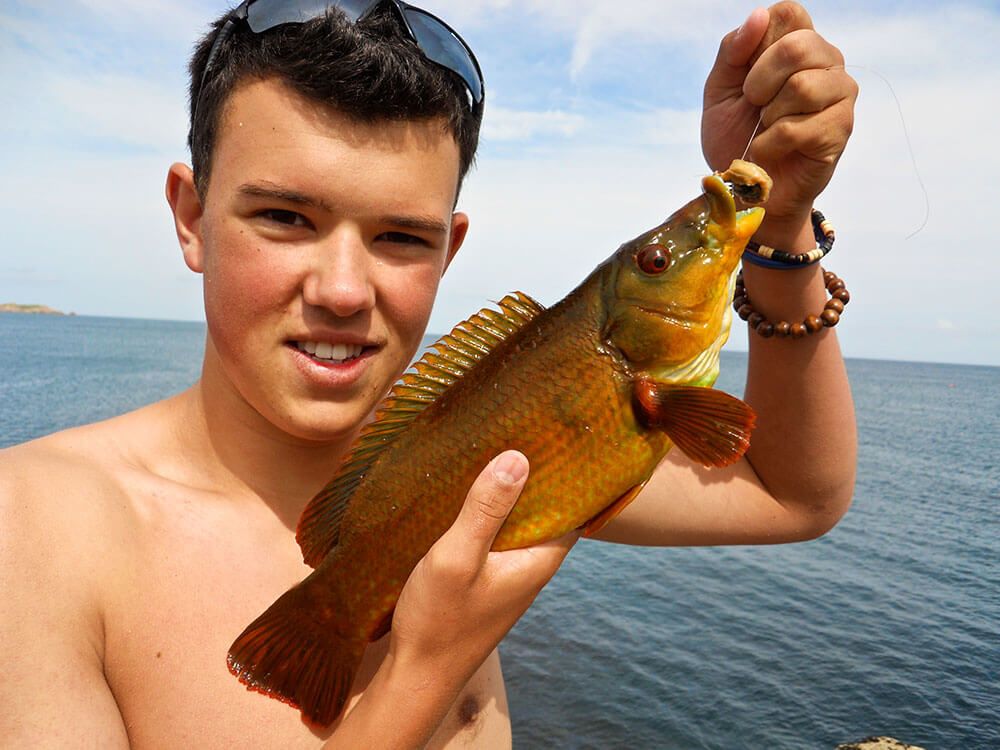
Whilst we had caught no specimens we were content with our success. I wondered what specimens lurked within these clear waters. I am sure a dedicated trip would unlock many of the Isle of Scilly’s secrets.
Next day we flew home passing over the spectacular Cornish coast, its cliffs edged by a surging white border of surf. Fishing villages nestled within rocky coves and sandy beaches with rolling surf. There is certainly an abundance of places to fish and no lifetime is sufficient to even scratch the surface.
Over the years I have packed a rod on many family holidays catching occasional specimens and numerous species. One of the joys of holiday angling is the people you meet. Sit on any quayside with rod in hand and inquisitive people compelled to ask that age-old question. “Caught anything mate?” will soon join you. Whilst this can become annoying it can also be a joy as stories unfold of fish, fishing, people and places.
I have caught grey mullet in Crete and Brittany as well as many areas of the UK. Last year a 30-minute session in Lymington harbour brought a 5lb 4oz grey mullet. So next time you go on a family vacation pack the rod and grab an hour here and there you may strike lucky.
Whenever I go on holiday I pack a small amount of fishing essentials to enable me to target the likely species available. So the first thing to do is a bit of research on the area to be visited. The first port of call is often the internet and a quick google search will often yield results. Keep your eyes scanned for any literature on the area you intend to visit; magazines often have relevant reports or articles. Old guide books are also well worth seeking out and give vital clues as to what may be caught. If possible try to tap into local knowledge. A contact at your destination is ideal, so ask around your mates. Sea angling forums are also worth a try though I have to admit to feeling a little uneasy asking total strangers for info, as they have no obligation to give away their hard earned secrets. Another essential is a tide table to enable careful planning of trips to coincide with the ideal tidal state.
If the holiday involves flying, luggage will be restricted, so tackle will need to be kept to a minimum. Travel rods are the only practical way forward with multi section or telescopic rods perfect for the job. A small rucksack can be packed with a couple of reels holding relevant lines, tackle and accessories. Bait and some items can be purchased when you arrive at your destination. This year’s holiday took us to the Isle of Scilly.
The Isle’s are a perfect destination for a family vacation with stunning scenery, white sandy beaches, boat trips, a multitude of shops and eateries. In addition to this the water clarity is truly stunning, proving a divers paradise with numerous wrecks and reefs over which to dive or snorkel.
The waters around Scilly have a rich population of fish for the angler to target with pollock, mackerel, garfish, grey mullet and wrasse perfect species for the holiday angler. Strangely, bass are very rare which surprised me as the habitat seems ideal. The angler prepared to take a boat trip could be rewarded with a blue shark. A shark topping 150lb was tagged and released from a boat during our stay. Evening trips are available with the shark grounds within easy distance of the islands.
My intention on this holiday was to have a go for the large thick-lipped grey mullet and perhaps try for a golden grey that populate many of the sandy beaches. There was also the opportunity to target wrasse or Pollock from deepwater rocky headlands.
I had been fortunate to make contact with an experienced local angler who gave us valuable advice on possible marks and location of species.
So with the species and terrain involved this is what we packed to enable my sixteen-year-old son James and I to have a cast or two.
TACKLE
Shimano – Travel spinning rod
ABU – Telescopic spinning
Shimano fixed spool reels.
One spool loaded with 8lb b.s mono and the second with 20lb b.s braid.
Small Snowbee rucksack.
1 pack Berkley jelly worms
1 Pack Berkley sandeel’s
Selection of floats
Weights up to 1 oz x 6
Split shot
Selection of hooks Sakuma sizes 8 to 3/0
Three way swivels
15lb b.s fluorocarbon hook length
8 lb.s fluorocarbon hook length
Forceps and line clips
Scissors

Armed with these basic bits of kit, it is possible to target a range of species. If we were visiting other venues I would review the artificials taken, substituting the jelly worms for plugs or spinners, if bass were likely to be present.
During our weeklong stay on St Mary’s my son and I enjoyed three short fishing sessions.
FIRST SESSION
The first session saw us walk out onto a headland that gave access to very deep clear water. We should have arrived two hours before high water but failed to get there until about half an hour before the top of the tide. A careful assessment must be made prior to starting to assess a safe place from which to fish. Always beware of large waves and consider tidal state and weather conditions.
My son James and I selected a rock that kept us well above the water with access to land a fish if it was hooked. A simple paternoster rig was used to present a jelly worm. 20lb braid was selected for this that would give us a fighting chance if a decent pollock was hooked. The lure was cast out and allowed to sink before being retrieved. The key is often to get the lure fishing as close to the bottom as possible without getting it snagged. When a Pollock is hooked a degree of pressure is needed to prevent it reaching sanctuary.

The scenery was truly stunning with lichen covered granite boulders, abundant wild flowers and a dramatic marine panorama. After two or three casts my jelly worm was hit by a small Pollock, this gave a moment of excitement before I realised its small size. After half an hour without further interest in our lures it was time to wonder off along the coast to try a few more spots. A Pollock close in eventually seized James’ jelly worm but in a split second the powerful fish had found sanctuary amongst the rocks.
With the tide now starting to ebb we decided it was time to call it a night. The walk back along the cliff path brought us upon an array of spectacular views. Granite formations, a tranquil bay, small boats at rest, bright wild flowers - all the sights that add to the delights of sea angling.

SECOND SESSION
We had been told of a sandy point at the North of the island that produced good catches of golden grey mullet. Low water flood was the time to fish the mark. With this in mind my wife Pauline and son James set off with me along winding country lanes to the mark. This was of course all part of the fun.
As luck would have it the weather forecast gave showers of rain that afternoon, though with warm sunshine when we left home, this seemed unlikely!
Eventually we arrived at the white sandy beach, Pauline prepared to stretch out in the sun whilst James and I headed for the foreshore in search of ragworm which could, I was told, be found beneath boulders that lay to the left and right of the sandy beach. Half an hour of heaving over rocks produced enough harbour rag for a couple of hours fishing.
James and I sauntered back up the beach for a snack with Pauline before using our bait. To our dismay as we sat down large spots of warm rain proceeded to fall. The sky gave no clear indication of how long it would prevail so we decided to give it a few casts despite the rain. Our luck held the rain soon eased.
After half an hour I had a sharp rattle on the rod tip but failed to connect. James then also enjoyed a signal of life transmitted through his braided line but the hook hold failed and it came adrift. Next cast my rod tip again dipped and I found my self attached to a fish of some kind. Seconds later a small brightly coloured wrasse was swung ashore to bring a smile to our faces.

Having fished two hours of the early flood tide it was time to head off to our cottage before walking into Hugh Town for a pub meal.
THIRD SESSION
Time flies far too fast whilst on holiday and our last day on Scilly came all too soon. A beautiful sandy beach with an adjacent rocky promontory was to be our venue. James and I would forage around for a little bait in and under the rocks. I had a loaf or two of bread to try and tempt a mullet.
At low water we walked out onto the end of the rocks. I mashed up a bag full of bread and started to toss it into the clear water. James set up with a simple paternoster rig and rotten bottom. A size 2 Sakuma circle hook was baited with a couple of limpets and swung into a deep kelp filled gully. I set up a light float rig in case a mullet or two appeared.

After a few minutes James called out and I turned to see his rod bent over its tip jagging to the pull of a fish. James applied plenty of pressure as instructed and bullied the fish towards the surface. A brightly patterned wrasse emerged from the water to be lifted ashore. The fish was admired and photographed. In the next hour two more wrasse were extracted from their rocky liar amongst the waving fronds of kelp.

Whilst we had caught no specimens we were content with our success. I wondered what specimens lurked within these clear waters. I am sure a dedicated trip would unlock many of the Isle of Scilly’s secrets.
Next day we flew home passing over the spectacular Cornish coast, its cliffs edged by a surging white border of surf. Fishing villages nestled within rocky coves and sandy beaches with rolling surf. There is certainly an abundance of places to fish and no lifetime is sufficient to even scratch the surface.
Over the years I have packed a rod on many family holidays catching occasional specimens and numerous species. One of the joys of holiday angling is the people you meet. Sit on any quayside with rod in hand and inquisitive people compelled to ask that age-old question. “Caught anything mate?” will soon join you. Whilst this can become annoying it can also be a joy as stories unfold of fish, fishing, people and places.
I have caught grey mullet in Crete and Brittany as well as many areas of the UK. Last year a 30-minute session in Lymington harbour brought a 5lb 4oz grey mullet. So next time you go on a family vacation pack the rod and grab an hour here and there you may strike lucky.

